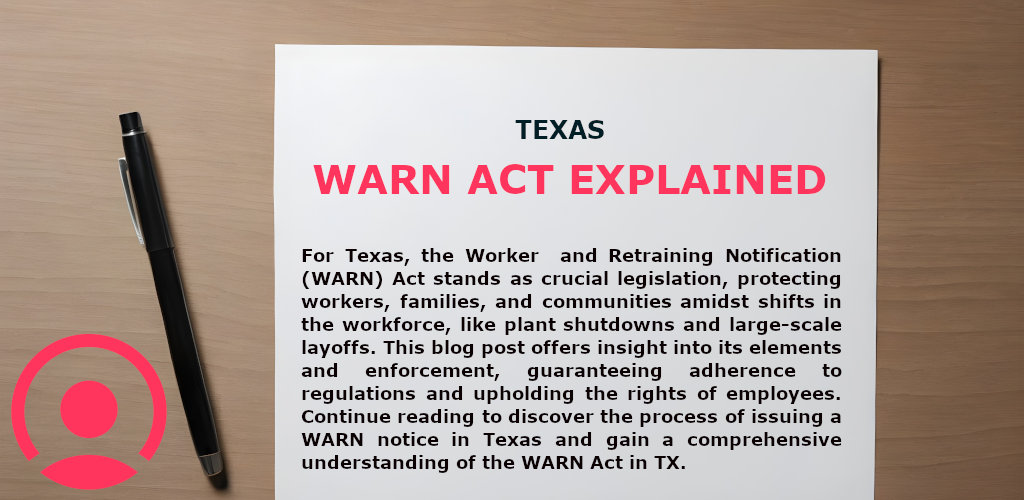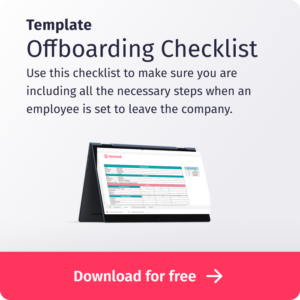For Texas, the Texas Worker Adjustment and Retraining Notification (WARN) Act stands as crucial legislation, protecting workers, families, and communities amidst shifts in the workforce, like plant shutdowns and large-scale layoffs. This blog post offers insight into its elements and enforcement, guaranteeing adherence to regulations and upholding the rights of employees. Continue reading to discover the process of issuing a WARN notice in Texas and gain a comprehensive understanding of the WARN Act in TX.
TABLE OF CONTENTS
- Does Texas have WARN Act?
- What is the Texas WARN Act?
- WARN notices in Texas
- What Triggers the WARN Act in Texas?
- Texas WARN Act Requirements
- How is the WARN Act Enforced in Texas?
- Offboarding your workforce during a layoff
- Offboarding solutions 🚀
Does Texas have WARN Act?
In Texas, similar to over half of the states such as Arizona, there’s no standalone state-level WARN Act. Nonetheless, Texas workers aren’t left unprotected. Federal WARN Act provisions still cover employees in Texas. Employers in the state are obligated to submit and issue WARN notices to employees, furnishing details about expected mass layoffs and plant closures, including the number of affected workers.
Contrary to states solely governed by the federal WARN Act like Ohio, Georgia, and Florida, some states, like California, New York, New Jersey, Illinois, and others, not only adhere to the federal regulations but also have their own distinct requirements outlined in their mini-WARN Acts.
What is the Texas WARN Act?
Texas’s WARN Act ensures protection for workers facing layoffs or plant closures. Employers in Texas are mandated to provide advance notice to employees when aware of impending closures or layoffs. This notice serves to offer employees adequate time to explore alternative employment options. It’s a necessary protection for employees in times when there is an increase in mass layoffs in the state of Texas.
The WARN Act operates independently of the Fair Labor Standards Act (FLSA), which establishes guidelines for minimum wage, overtime, and unemployment benefits. The FLSA is not to be confused with the Family and Medical Leave Act (FMLA) in Texas.
On a similar note, however, Texas holidays are determined both federally, and locally per state. Check out our federal holiday calendar for an updated and complete list.
WARN notices in Texas
In Texas, issuing WARN notices entails a mandatory 60-day advance notification for employees impacted by layoffs or plant closures. When unionized workers are affected, notifications are directed to union representatives rather than individual employees. Although there isn’t a prescribed template for the notice, it must be documented and contain essential details such as the location and date of closure or layoffs, the rationale behind the decision, whether the job loss is permanent or temporary, affected job titles, union affiliations, the number of affected employees, and contact information for further inquiries.
See previously issued WARN notices for the state of Texas here.
Who do Texas employers have to give a WARN notice?
Employers falling under the jurisdiction of this act are obliged to furnish written notification to impacted employees, the labor unions representing them, the State Rapid Response Coordinator, and the primary elected official of the local government where the workplace is situated. This notification should be dispatched a minimum of 60 days prior to the expected plant closure or significant layoff event.
What Triggers the WARN Act in Texas?
Certain situations trigger the WARN Act in Texas:
1. Plant closings affecting 50 or more employees for at least 30 days.
2. Mass layoffs involving at least 500 full-time employees.
3. Mass layoffs involving at least 50 full-time employees, constituting 33% or more of the employer’s workforce.
4. Plant closings or layoffs extended over 90 days.
What is a plant closing?
When an employment site or facility shut down results in an employment loss for 50 or more employees during a 30-day period.
What are mass layoffs?
When a mass layoff does not result from a plant closing, but leads to an employment loss for 500 or more employees during a 30-day period, or for 50-499 employees if they constitute at least 33% of the employer’s active workforce.
What are extended layoffs?
When the employment losses for two or more groups of workers put together, each falling below the minimum threshold for notice, reach the threshold level during any 90-day period for either a plant closing or mass layoff.
Read also: What is a reduction in force?
Texas WARN Act Requirements
In Texas, employers are covered by the WARN Act if they have 100 or more employees, excluding those with less than six months of service in the last 12 months or those working an average of less than 20 hours per week. The Act applies to private, for-profit employers, private, nonprofit employers, and public and quasi-public entities operating in a commercial context.
Employees entitled to notice under the WARN Act include hourly and salaried workers, as well as managerial and supervisory employees. However, business partners are not entitled to notice.
The core focus of WARN Act requirements in Texas is on notification. Employers must provide advance notice before a change in employment affecting many employees.
The state of Texas encourages all employers to issue a WARN notice, regardless of whether they are legally required to do so by meeting the WARN act minimum employee threshold or any of the other criteria.
How is the WARN Act Enforced in Texas?
Enforcement of the Texas WARN Act is carried out through the United States District Courts. Workers, their representatives, and units of local government have the right to bring individual or class-action suits against employers believed to be in violation of the Act. The court may, at its discretion, award reasonable attorney’s fees to the prevailing party as part of the costs.
Read also: Texas Labor Laws you need to know
Violations of the WARN Act, including failure to adhere to notification period requirements, may result in back pay for affected employees and penalties of up to $500 per day of violation. Employers are required to settle liabilities with aggrieved employees within three weeks of closure or layoff. Failure to comply may lead to individual or class-action lawsuits in the U.S. District Court. Consult with Texas labor lawyers to address potential violation claims and always read the official sources before making any decisions, as laws are subject to change.
Why is the Texas WARN Act important?
Understanding the intricacies of the Texas WARN Act is essential for HR managers to navigate workforce changes compliantly and ensure the rights of employees are upheld during significant transitions. This guide covers key aspects, providing a foundation for effective compliance and transparent communication during challenging times.
Related: Compliance calendar for HR
Offboarding your workforce during a layoff
Once you’ve followed all the required steps mandated by Texas during plant closings and mass layoffs, it’s time to begin the offboarding process at your company. Offboarding so many employees at the same time can be a time consuming and costly process, but with the right HR software, it can be easy.
How to offboard employees with HR software
Factorial simplifies the offboarding process, streamlining tasks and ensuring a smooth transition for departing employees. With Factorial, you can efficiently manage exit procedures, such as collecting company assets, updating access permissions, and conducting exit interviews. Offboarding software simplifies the entire process from start to finish.
Key Features for offboarding during layoffs:
1. Clear Communication: Easily communicate departure details to the departing employee, including the last day of work, return of company property, and other essential information.
2. Task Automation: Automate offboarding tasks, such as revoking system access, updating records, and notifying relevant departments, saving time and minimizing the risk of oversight.
3. Documentation and Compliance: Ensure compliance by generating necessary documentation, such as termination letters and exit surveys, helping you maintain a comprehensive record of the offboarding process.
4. Access Control: Centralize access control management, making it simple to revoke access to company systems and confidential information, safeguarding your organization’s data.
By utilizing Factorial for offboarding, HR managers can enhance efficiency, maintain compliance, and provide a positive experience for departing employees.










